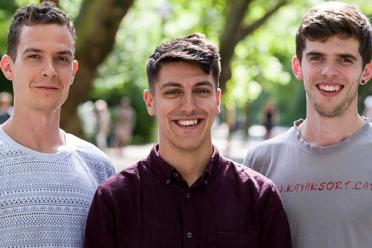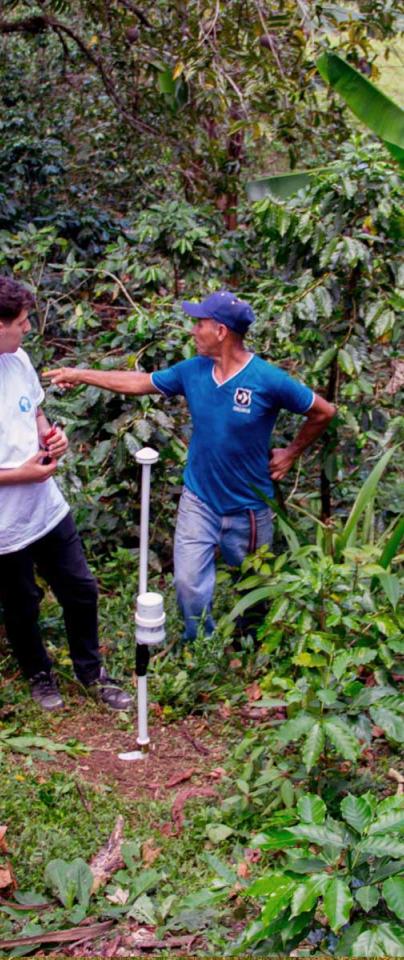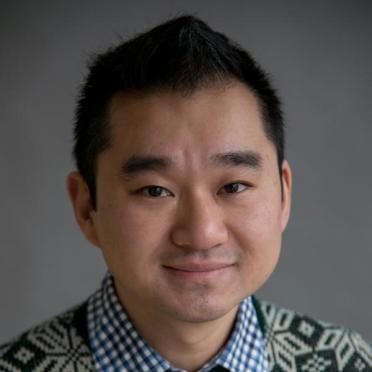Climate Edge: Precision agriculture for smallholder farmers
Climate Edge have a big data solution for helping smallholder farmers: linking local climate monitoring to on-farm applications.
At last year’s Thought for Food competition, London-based start-up Climate Edge were one of the ten amazing finalists to pitch for the grand prize with their big data solution for precision farming: helping smallholder farmers by linking climate indicators to on-farm activities. James Alden, co-creator of the start-up and business developer, explained to us the vision of Climate Edge, how they're helping farmers, and where the future of big data and farming lies.
Our team is motivated by making a big impact on the smallholder agriculture market. Smallholder farming communities are some of the most underserved communities in the world, both in terms of economic opportunities and access to technology. However, there are many opportunities to innovate in this space to support farmers and the wider value chain, which is what we are trying to do. We are excited to be entering this market at a time where our work can shake up the industry and make a big difference.
Climate Edge gives smallholder farmers globally the information needed to adapt to the devastating changing climate. Our agricultural weather stations and blended satellite imaging identify how yield and quality of crops are being impacted by key climatic variables, at an affordable price for the market we are working in.
Through this accessible approach we can provide the 500 million farmers growing the world’s most valuable crops the necessary information to grow stable and profitable businesses.

In essence, we are attempting to bring precision agriculture to smallholders. Currently, there is a large gap in the development of technology designed for smaller scale agriculture. Large commercial farms have access to expensive precision agriculture machinery, such as expensive irrigation systems, or tractor add-ons which allow variable fertiliser application. But this technology is far out of the reach of, or completely not applicable to, the majority of smallholder farmers, leaving them at the mercy of the environment around them with few options moving forwards.
Our bread and butter is linking climate indicators to on-farm activities. For example, providing short-term pest and weather alerts and long-term farm management advice, based on the farm specific data we collect. I wouldn’t define this element of our work big data.
However, once our network and database expand, and the data is aggregated, this is when big data analytics comes into its own. Our long-term vision is to use our data collection infrastructure to enable the establishment of a number of other services targeted to improving smallholder profitability and stability. These will include insurance products which work, access to new markets, and reliable access to finance.
Farm management advice is our foothold to create much larger changes within the sector.


Smallholder farming communities are some of the most underserved communities in the world, both in terms of economic opportunities and access to technology.

One project we are currently working on is with Catracha Coffee in Honduras. Catracha work closely with coffee farmers, processors and traders, maintaining a high quality, fair supply chain from seed to cup. They are using our Nexo weather stations on several farms to help them improve coffee production in the area, ensuring they are economically and environmentally sustainable in the looming face of climate change.
Later this year we will begin a World Bank funded project with Producers Direct in Uganda, examining how digital data can be most efficiently integrated into the smallholder agriculture system. This will see a larger roll-out of both our hardware and software products at the smallholder level, so we are really excited, and grateful to World Bank and our other partners for making it happen.
Smallholder farming is currently a number of steps behind other global agricultural systems, particularly in the tropics. Many of the farmers we have worked are incredibly isolated from high-tech products which improve efficiency, up-to-date agronomic models and finance management software - all of which are mainstays of European and US agriculture.
The technology to provide data-driven farming is not the problem, which is a great position to be in. The challenge is in creating business models that allow these technologies to be uptaken in the market. Once this has been achieved in a scalable way, I see data-driven farming practices completely changing the global agriculture market, as much more information (and therefore power) will be put in farmers hands.

Many of the farmers we have worked are incredibly isolated from high-tech products which improve efficiency, up-to-date agronomic models and finance management software.

My hope is that the finalists this year are as driven and motivated to make change in agriculture as the cohort I was in last year; which I have no doubt they will be!
I believe that the main benefit of the Thought for Food competition is the community it is establishing, and this motivation is what keeps the community going. As an example from ourselves, we are looking to develop a project to support farmers in post-conflict regions with last year’s winners, Cultivando Futuro, from Colombia - a great opportunity for us which would not have been possible without the presence of the global TFF community.
Scale up. We are now confident in our technology’s ability, and the value it provides, but we have currently only worked on small-scale pilot projects and proof of concepts.
The next step, to have a big impact on the smallholder market, is to begin scaling up our work, getting the feedback of large numbers of users, and iterating our design to ensure that we are continually meeting the demand of our users.
We are excited to see what the future holds!

The Zhou Group of EI are at the heart of developing precision agriculture solutions. With projects such as AirSurf and CropQuant, as well as international collaborations with organisations such as Nanjing Agricultural University (NAU) in China, the Zhou group is pioneering in-field phenotyping solutions tied with advances in AI and machine learning.